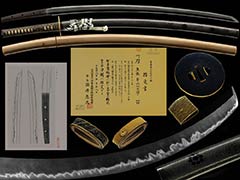
重要刀剣 Juyo Token
片山一文字 刀Katayama Ichimonji Katana
No.513083刀 片山一文字 則房極華やかな逆丁子傑作 細川家伝来 時代打刀拵付 二尺三寸一分Katana Katayama Ichimonji Norifusa's gorgeous Saka-Chouji masterpiece, Hosokawa family tradition, With Jidai Uchigatana Koshirae 69.9cm
ご成約Sold
- 極めKiwame
- 片山一文字Katayama Ichimonji
- 登録証Registration
- 山形県 Yamagata 昭和29年11月18日 11/18/29(Showa)
- 時代Period
- 鎌倉中期 Middle Kamakura period
- 法量Size
-
刃長 69.9cm (二尺三寸一分) 反り 2.4cm
元幅 2.8cm 先幅 1.9cm 元重 0.61cm 鎬厚 0.68cm 先重 0.50cm 鋒長 2.9cm 茎長 18.9cm 重量 705gHachou 69.9cm (二尺三寸一分) Sori 2.4cm
Moto-Haba 2.8cm Saki-Haba 1.9cm Moto-Kasane 0.61cm Shinogi-Thikess 0.68cm Saki-Kasane 0.50cm Kissaki-Chou 2.9cm Nakago-Chou 18.9cm Weight 705g - 国Country
- 備前Bizen
- 姿Shape
- 鎬造、庵棟、身幅尋常、反り深く、腰反りつき、中鋒。Shinogidukuri, Iorimune, Standard Mihaba, Deep Sori, Koshizori-tsuki, Chu-Kissaki
- 鍛Kitae
- 板目肌に、杢目肌交じり、地沸微塵につき、乱れ映りたつ。Itamehada, Mixed Mokumehada, Jinie entered finely, Midare-Utsuritatsu.
- 刃文Hamon
- 逆がかった丁子乱れに、蛙子調の丁子・重花調の丁子・互の目など交じり、飛び焼きかかり、逆がかった足入り、足・葉頻りに入り、匂出来、小沸深く付き、匂深く、匂口明るい。Sakagakatta-Chouji-Midare, Kawazuko-style Chouji, Juka-style Chouji, Mixed Gunome, Tobiyaki-kakari, Sakagakatta-Ashi entered, There are many Ashi and You, Nioi-deki, Deep Small-Nie-tsuki, Deep Nioi, Nioikuchi is bright.
- 帽子Boushi
- 直ぐに小丸。Suguni-Komaru
- 茎Nakago
- 大磨上、先切、鑢目切、目釘孔三。Oh-suriage, Sakikiri, Yasurimegiri, Mekugiana are three(3).
- ハバキHabaki
- 金着一重。A single layer of gold.
- 拵Sword mounitings
- 黒石目地塗家紋散影蒔絵鞘打刀拵 [江戸時代]
法量
長さ 100.0cm 反り 4.3cm
説明
鐔 赤銅磨地金覆輪、
縁 羽州米沢住 横谷宗寿 花押 赤銅竹に虎図魚々子地金色絵家紋金据紋
目貫 赤銅地二匹竜図。細川家伝来。Kuro Ishimeji-nuri Kamon Chirashi Kagemakie Saya Uchigatana-Koshirae(Edo period)
Length:100cm
Sori:4.3cm
Tsuba: Syakudou Migakiji Kinpukurin
Fuchi: USyu Yonezawa jyu Yokotani Munetoshi Kaou Syakudou Takenitorazu NAnakoji Kiniroe Kamon Kin-suemon
Menuki: Syakudouji Nihiki Ryuzu
Passed down from the Hosokawa family.
- 説明Drscription
- 則房は、福岡一文字助房の子と伝え、助真・吉房とならんで最も華やかな丁子乱れを焼き、鎌倉時代中期の一文字派を代表する刀工である。則房は、のち福岡より片山に移住して作刀したと伝え、片山一文字と呼称される。従来、片山なる場所については備中国とするのが通説であったが、近年、備前福岡近在の片山ではないかとする説が浮上し、有力視されている。作風は、助真・吉房に類する華やかな丁子乱れのものの他に、地沸が微塵について強く冴え、映りの目立たないもの、逆ごころの刃が目立つもの、小模様のものなどがある。この刀は、反り深く、腰反りつく鎌倉中期の優美な太刀姿で、乱れ映り立つ精良な地鉄に、丁子乱れが逆がかっていかにも華やかで、重花丁子・蛙子丁子・互の目など複雑に交えながら、飛び焼きかかり、逆足・足・葉頻りに入り、小沸深くつき、匂深く、匂口明るく、則房の特色が良く表れた同行極めの傑作である。目立つ傷欠点も無く頗る健全となる細川家伝来の名品である。Norifusa is said to be a child of Fukuoka Ichimonji Sukefusa, and along with Sukezane and Yoshifusa, he burns the most gorgeous clove disorder and is a swordsmith representing the Ichimonji school in the middle of the Kamakura period.Norifusa later moved to Katayama from Fukuoka and reportedly made a sword, and is called Katayama Ichimonji.In the past, it was generally accepted that the place called Katayama was Bicchunokuni, but in recent years, the theory that it may be Katayama near Bizen Fukuoka has emerged and is regarded as promising.In addition to the gorgeous Chouji-midare style similar to Sukezane / Yoshifusa, Jinie has a strong sense of fine dust and Utsuri's inconspicuous style. Some of Gyakugokoro's blades stand out, and some have small patterns.
This sword is an elegant Tachi from the mid-Kamakura period, deep Sori, Koshizori-tsuku, Midare-Utsuritatsu clear Jitetsu, Chouji-Midare Sakagakari gorgeous, Juka-style Chouji, Kawazuko-chouji, While mixing complicated things such as Gunome, Tobiyaki-kakari, Sakaashi, There are many Ashi and You, Small-Nie entered deeply, Deep Nioi, Nioikuchi is bright, This is Kiwame's masterpiece that clearly shows the characteristics of Norifusa.
It is a masterpiece handed down by the Hosokawa family and has no noticeable scratches or imperfections.






